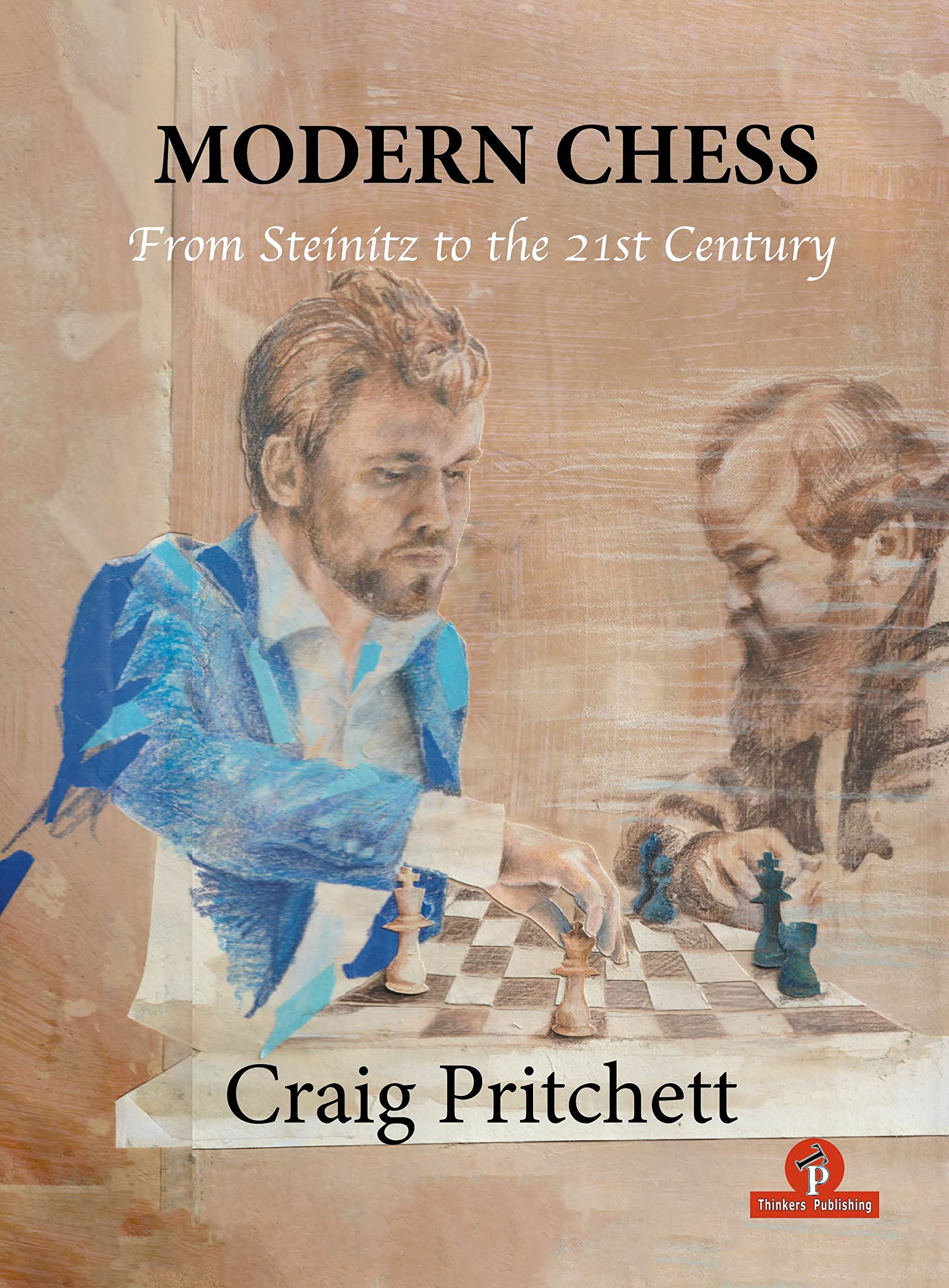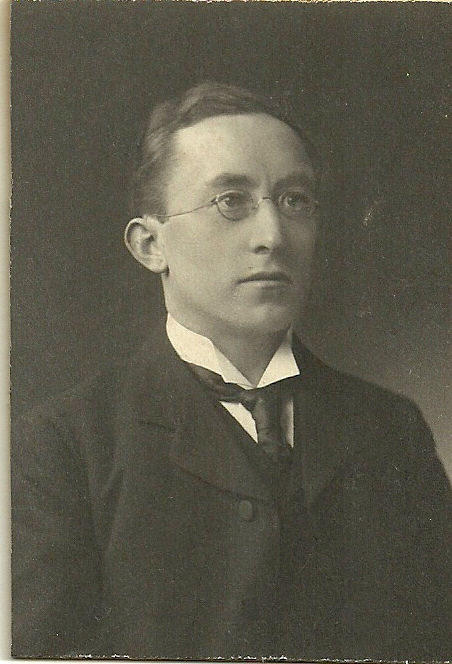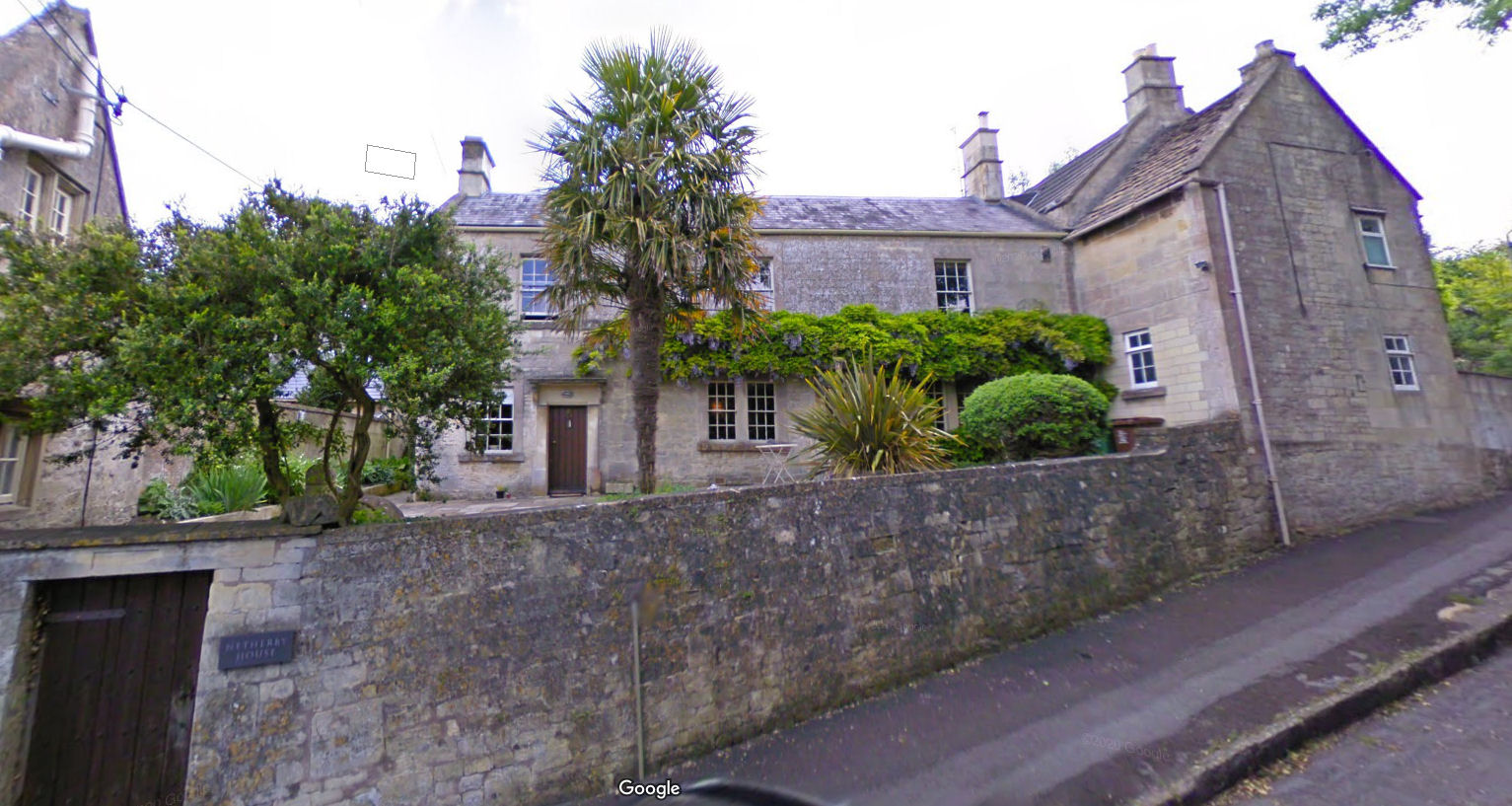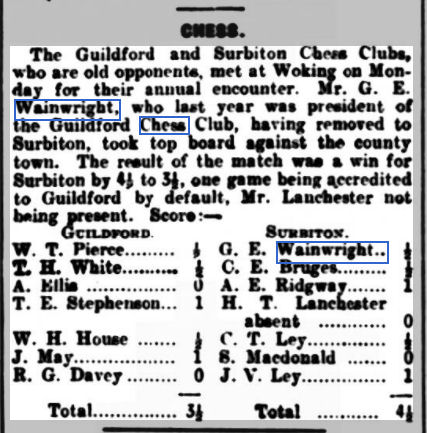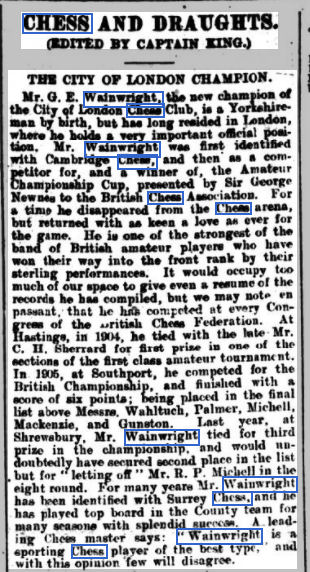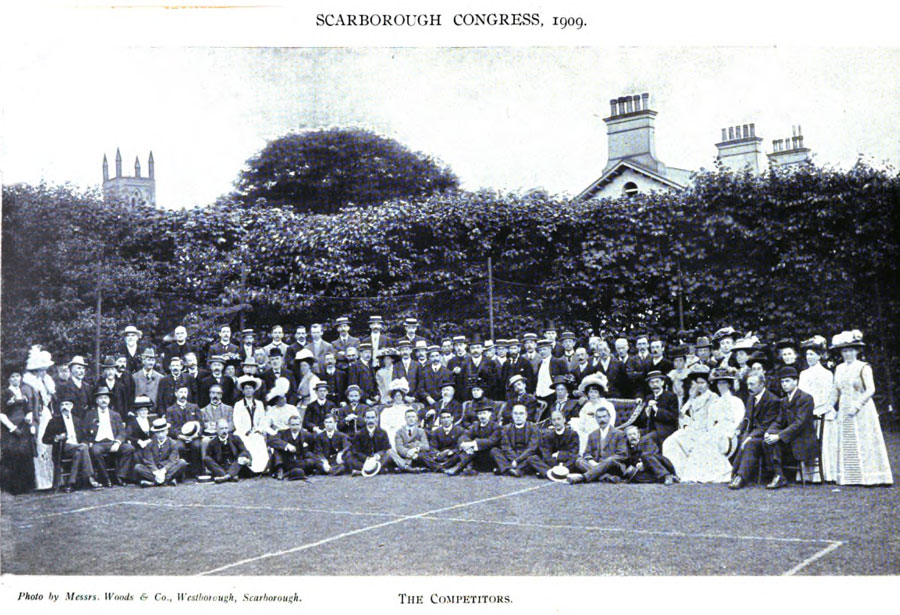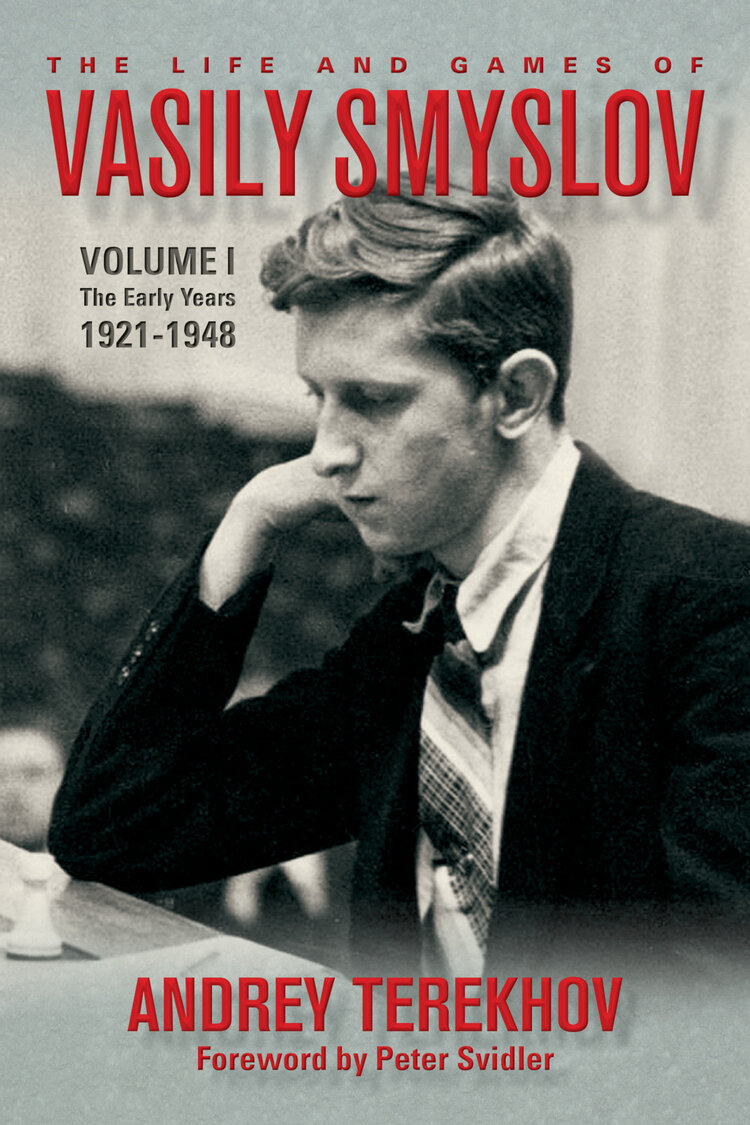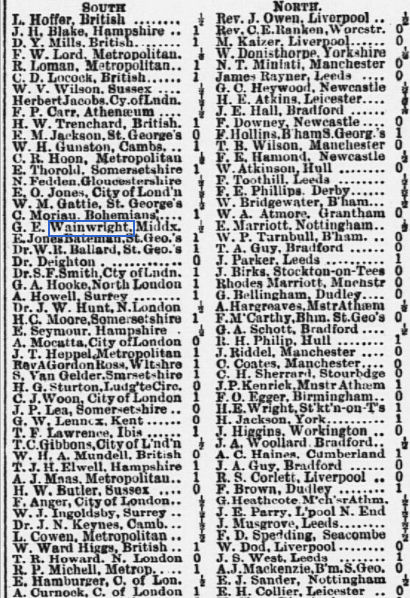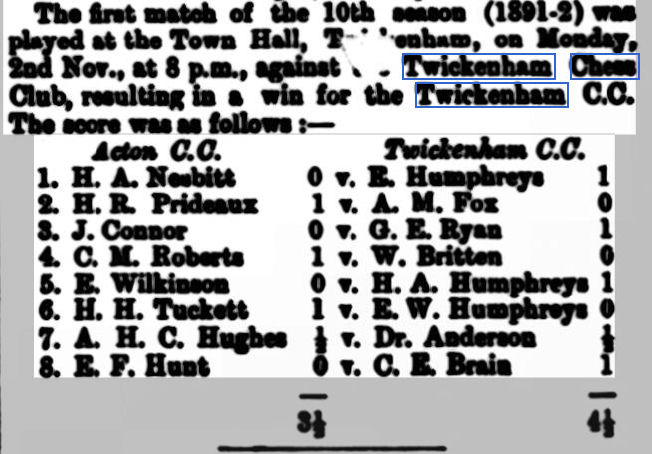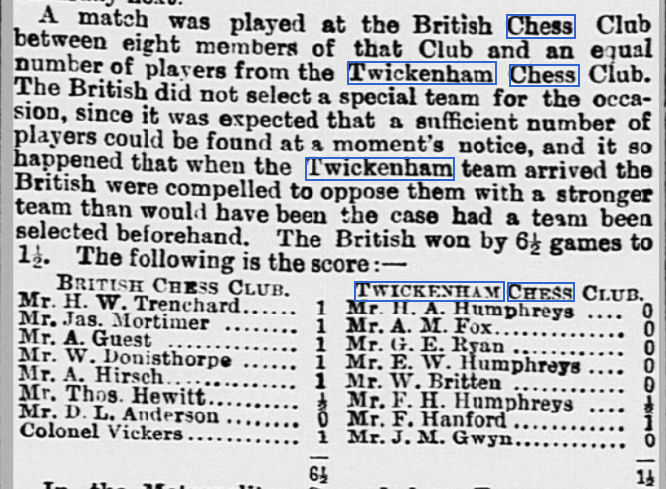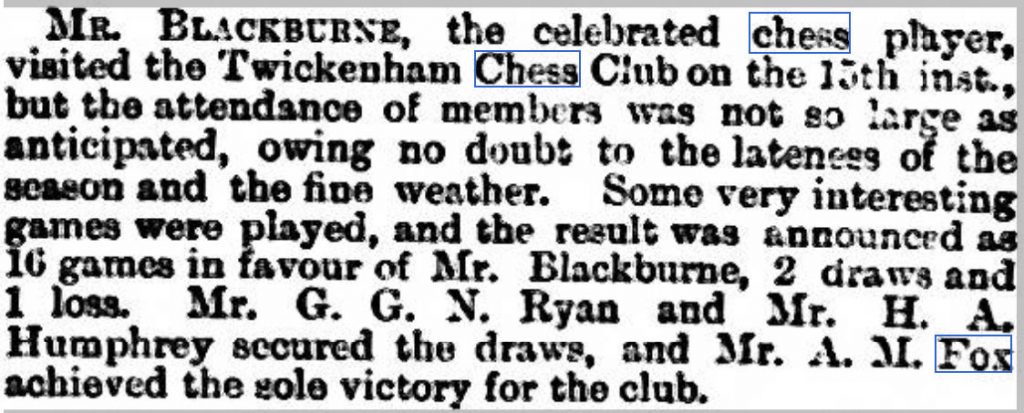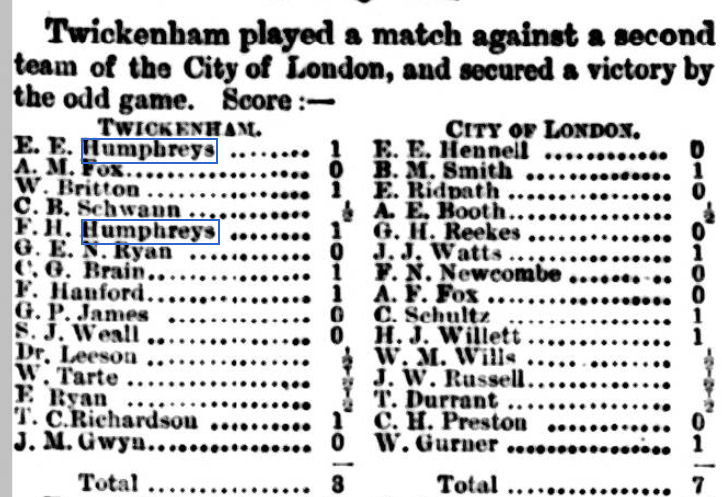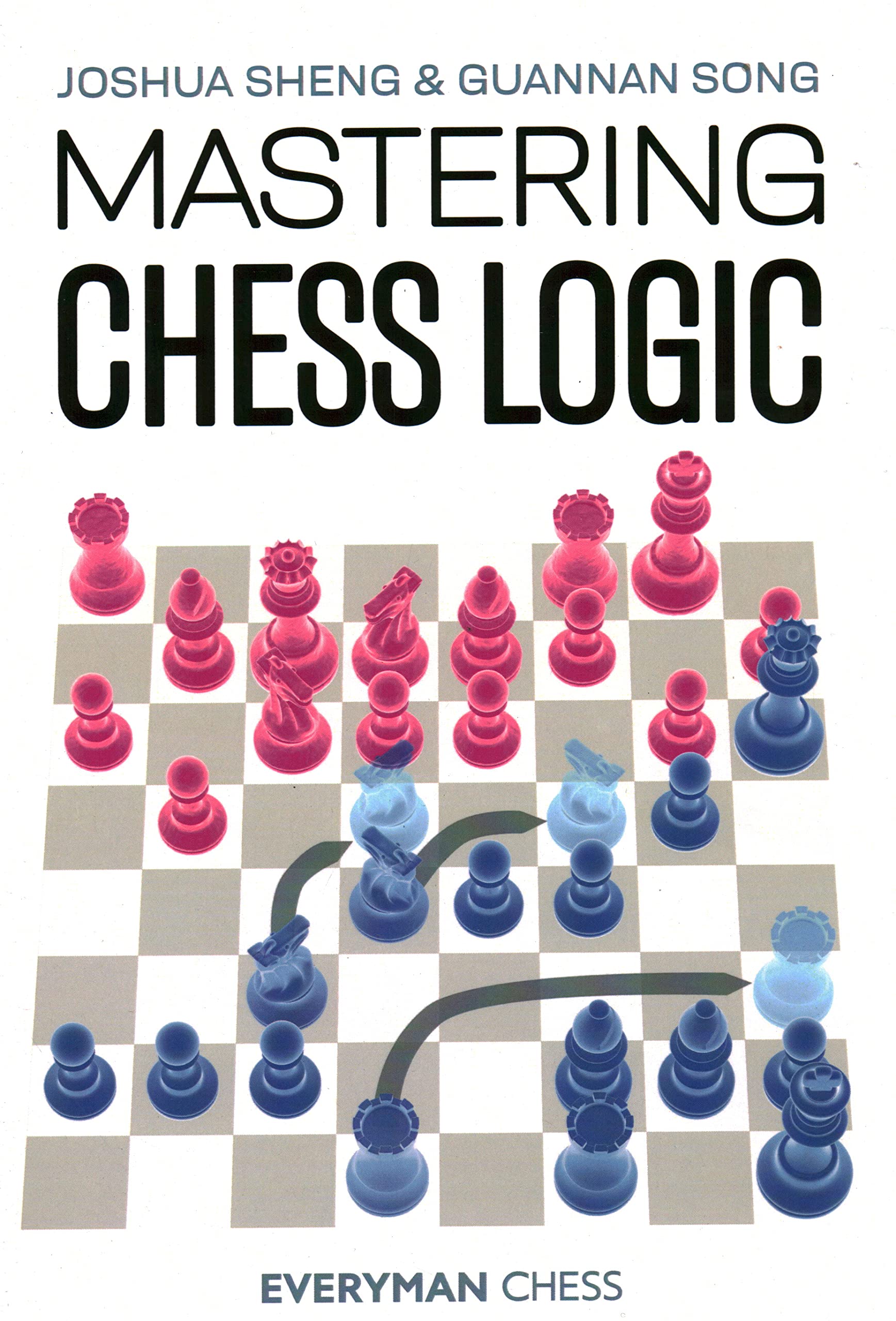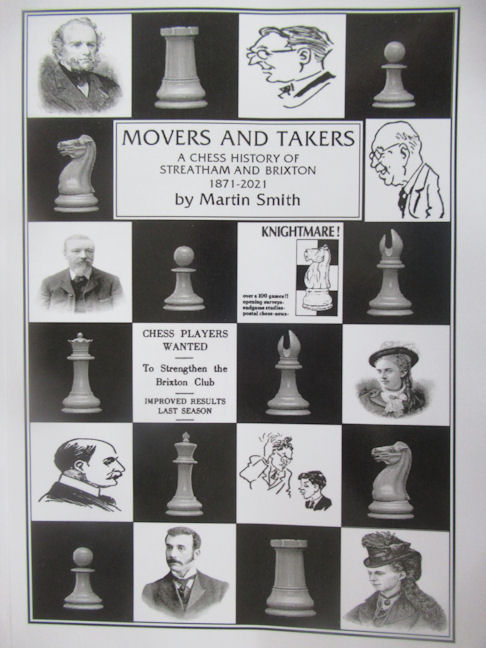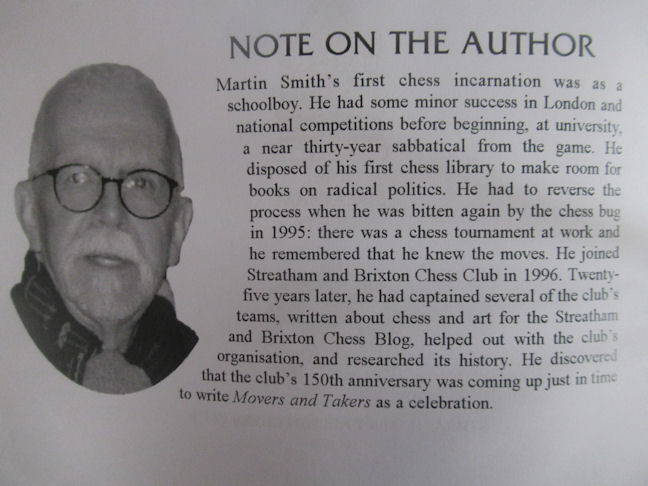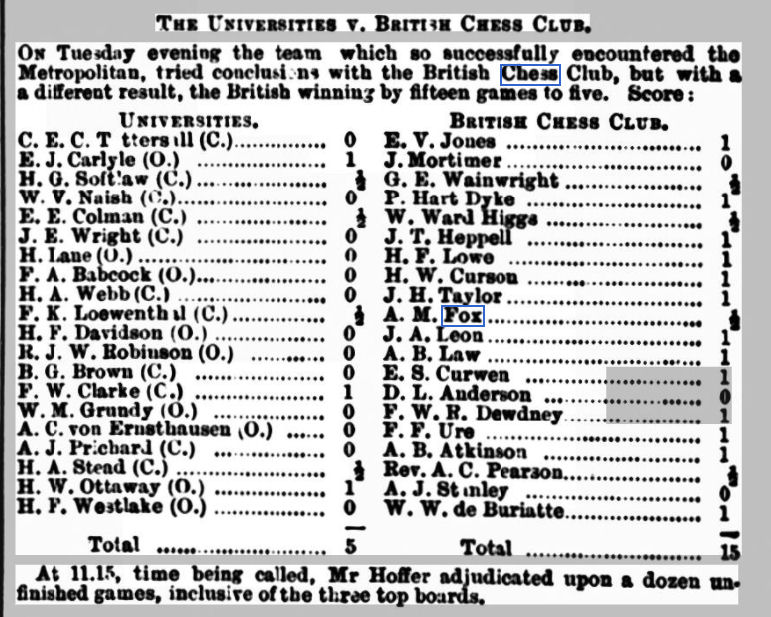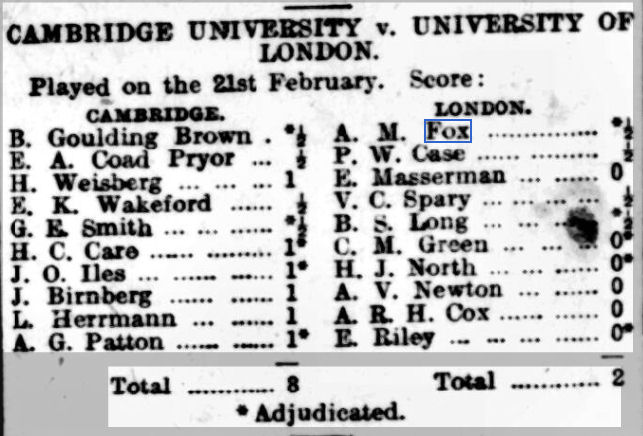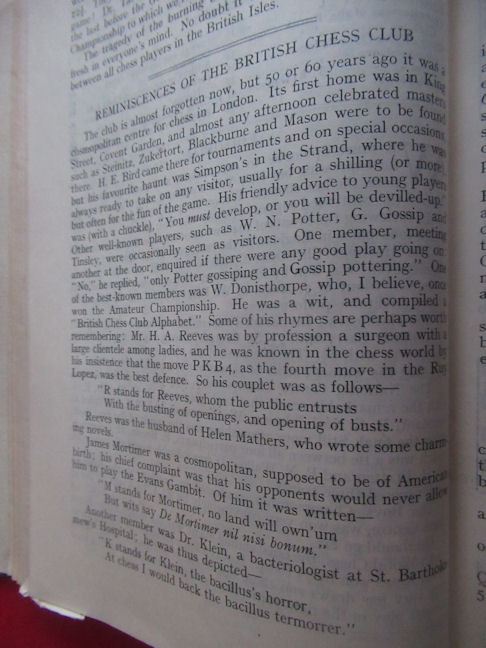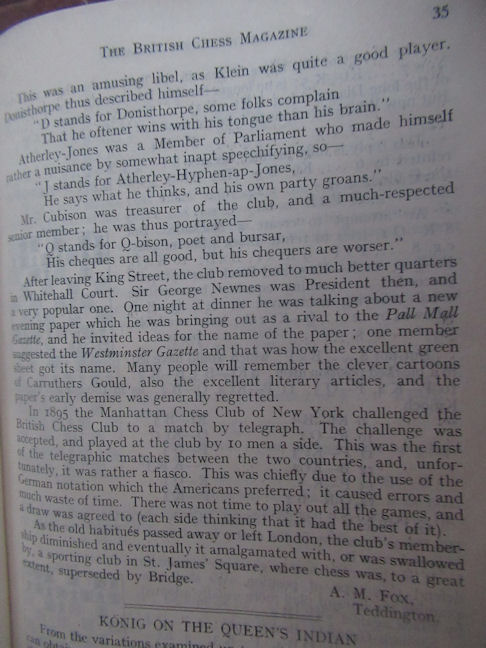Last time we left George Edward Wainwright at the time of the 1921 census, when, approaching the age of 60, he’d recently retired from his senior post with the now defunct Local Government Board and moved to his wife’s home village of Box, not far from Bath.
Chess in London for him was now over: no more City of London Championships. But, as always, he’d wasted no time in joining his nearest chess club, in the City of Bath.
The first record we have for him there was the previous December where he defeated the celebrated problemist Comins Mansfield on top board in a match against Bristol & Clifton. (Bristol’s Board 10, intriguingly, was Agnes Augusta Talboys (née Snell), an artist famous for her paintings of Persian cats, sometimes playing chess.)
The 1921 British Championship Congress was held in Malvern, and it was here that George Edward Wainwright scored one of his best results, sharing third place with Reginald Pryce Michell, behind Fred Dewhirst Yates and Sir George Alan Thomas.
Here he is in play against Roland Henry Vaughan Scott.
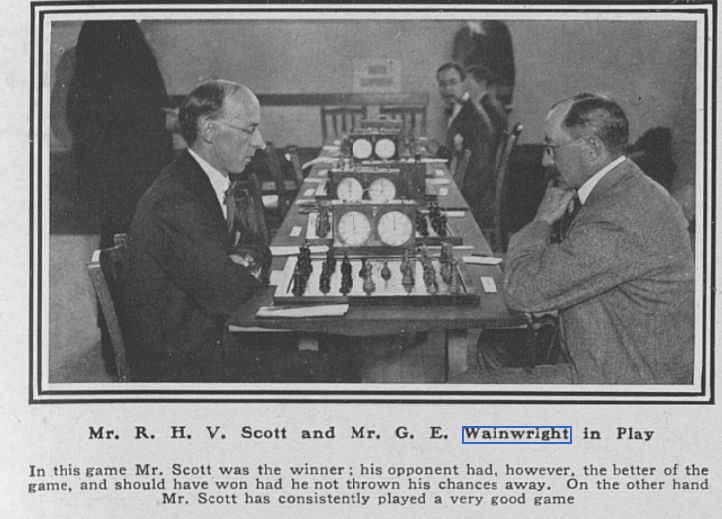
Stockfish 14 doesn’t agree that Wainwright should have won this game. Opening up the kingside left his own king the more exposed, and Scott found a rather unusual winning move.
Here’s the game. (Click on any move in any game in this article for a pop-up window.)
He had some luck in a couple of other games. Sir George Thomas, better known as a steady positional player, gave up material but misplayed the attack, erring on move 20.
Michell played a Maroczy Bind against Wainwright’s Sicilian Dragon, gained an overwhelming positional advantage but lost the thread, and, with the draw in hand, allowed transposition into a lost pawn ending.
There was no competition for the British Championship in 1922: the congress itself, in London, featured an international tournament (1st Capablanca, 2nd Alekhine) as its top section. Wainwright didn’t take part but may well have visited as a spectator.
He was back again at Southsea in 1923, where he scored a creditable 6/11 (no draws: remarkably there were only eight drawn games out of 66), finishing in 5th place. Sir George Thomas took the title for the first time, with Yates just behind in second place. Sir George also won the Men’s Singles in the All England Open Badminton Championship in the same year, a feat which will surely never be repeated.
Wainwright was snapped again by The Sphere, this time in a game he won against tournament tail-ender William Gooding. Unfortunately, the moves of this game are unavailable.
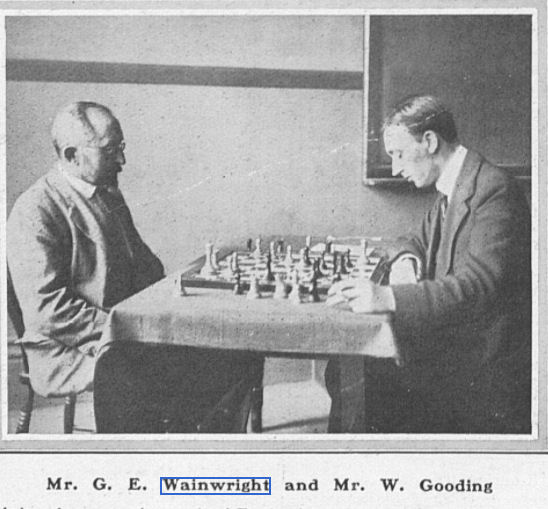
Against the Scottish solicitor William Gibson, he built up a slow kingside attack, concluding with a queen sacrifice.
Wainwright also sacrificed his queen against the Australian Civil Servant Charles Gilbert Steele. (Steele would meet a premature death the following year, falling off a railway station platform in front of an oncoming train.) Despite Stockfish’s double exclamation mark for artistic merit it only turned a winning position (34… Kf8!) into a level position, but he was later able to force resignation by sacrificing one of his rooks.
This time round he beat Roland Scott in a fluctuating game, essaying the English Opening, which was just starting to become popular.
In 1924 a chess festival was held in Weston-Super-Mare, with the participation of future world champion Max Euwe (1st) from the Netherlands, the Paris-based Russian master Eugene Znosko-Borovsky (3rd) and eight English amateurs led by Sir George Thomas (2nd). George Edward Wainwright was invited to take part, but only managed a disappointing 1½/9. He lost his first six games, drawing with Cyril Duffield of Bristol in round 7 and finally managing a win against local player Captain Percivale David Bolland in the final round. (Capt Bolland was a retired and disabled army officer who had served in the Welch Regiment and would later find employment as a Laundry Manager.)
Here’s his final tournament game in which he faced the dashing Max Lange Attack, winning when his opponent blundered on move 34.
Perhaps discouraged by this result, Wainwright decided to retire from tournament chess, although he continued playing club chess until Spring 1926. One of his last games, which I may look at elsewhere, was again against Comins Mansfield, where he lost a winning rook ending two pawns up.
In January 1933 his friend Charles Dealtry Locock (another important but forgotten figure in British chess who deserves a Minor Piece or two) wrote about him in a memoir in the British Chess Magazine.
In 1881 I went to the University College, Oxford, and finding that the hon. secretary of the ‘Varsity Chess Club was at that college I at once left a card on him. A few hours later came a knock on my door, and entered a man, one year my senior, with a round bespectacled face, who announced himself as G. E. Wainwright. We did not guess then what hundreds of games we should play together, nor how often the rosy-fingered Dawn would surprise us still playing. On this occasion we had a trial game and Wainwright defeated me with a King’s Gambit.
George Edward Wainwright died on 31 August that year at the age of 71, his death being registered in Keynsham, near Bristol, a place a whole generation grew up knowing how to spell.
Another friend – and opponent in City of London Championships, Philip Walsingham Sergeant (Edward Guthlac’s second cousin and notable chronicler of British chess) wrote an obituary for the October 1933 issue of British Chess Magazine.
Though he had dropped out of chess for some years – practically since he retired from Government service and went to live at Box, Wiltshire – the death of G. E. Wainwright came as a painful shock to his very numerous friends of the past, to whom his bright and mercurial temperament was still a pleasant memory. His achievements at chess are also still vivid in the mind though not, of all, since many of them go back well into the past.
Born in Yorkshire on November 2, 1861, G. E. Wainwright went up to University College, Oxford, in 1880, and in the Michaelmas Term of the following year he was hon. secretary of the O.U.Ch.C. (see an article by his friend C. D. Locock in our January number of the present year), while in 1882 he became president. He played five times for Oxford, a record which he shared with Locock, W. M. Gattie, the Rev. E. H. Kinder, and R. W. (later Sir Richard) Barnett; for in those days there was no such limitation as there is to-day with regard to playing for one’s University. He was 6th board in 1881 and 2nd board in 1882-5, scoring in all 4 wins, 2 draws, and one loss. After leaving Oxford he quickly made his mark in metropolitan chess, indeed in English chess generally. In 1889 he won the Newnes Challenge Cup, which was equivalent to the Amateur Championship. In later days he competed in the B.C.F. tournaments for the British Championship in 1905 (when he was 6th), 1906 (equal 3rd), 1907 (eq. 2nd), 1909 (eq. 6th), 1910 (eq. 4th), 1920 (8th), 1921 (eq. 3rd), and 1923 (5th).
At the City of London Chess Club he was always to the fore, and won the championship twice, in 1907 and, after a triple tie, in 1918.
He played in the Anglo-American cable matches five times, in 1899, 1907, 1908, 1909, and 1910, his highest board being 4th in 1909.
Wainwright will be vividly remembered by all his opponents of old for his remarkably rapid play. Yet the present writer remembers one occasion on which Wainwright took three-quarters of an hour over a single move against him – duly apologising afterwards, though the position was exceedingly difficult. Three-quarters of an hour over a whole game was more like his usual style! He was a great springer of ‘wild-cats’ on his adversaries; and his attacks, even when unsound, were very difficult to meet, inspired as they were by a strong personality, very rapid sight of the board, and a healthy confidence. In addition, he had studied the game deeply, beginning in his University days, if not sooner.
George Edward Wainwright was an important, but mostly forgotten figure in English chess, of master standard at his best, with a highly attractive style of play. Apart from this obituary, there’s little about what he was like as a person, but his vivacious attacks and speed of play were often mentioned. It’s clear he was a lifelong chess addict, and if Sergeant’s obituary is anything to go by, a splendid chap as well. We can certainly see traits of loyalty – to his career-long job in the Local Government Service, and to his family, from caring for his elderly mother to retiring to his wife’s home village.
It remains to look at what happened to his children.
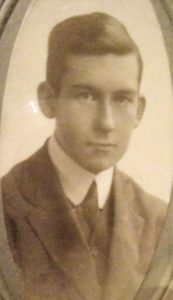
George Edward junior was, as we’ve already seen, also a chess player, but at a lower level, and, like his father worked in local government – in Ilkley, where his father grew up.
In 1916 he married Jane Savile, who had previously been married briefly to a Polish waiter, an ‘illegal alien’ who had moved to London and committed various criminal offences. They moved to Liverpool and later, it seems down to Surrey, where he died in 1950.
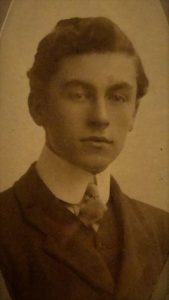
Philip Francis Wainwright worked in the photography business, but served as a paymaster in the Royal Navy in the First World War. For some reason he changed his surname to Pictor-Wayne – Pictor being his mother’s surname. In the 1920s his business hit financial problems and he was declared bankrupt. He lived in London, married and had a son, but later returned to the Bath area where he died in 1969.
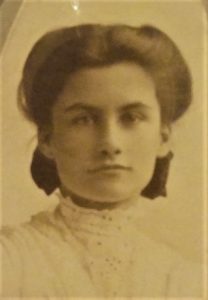
Constance Margaret Wainwright married a first cousin, Alan Newman Pictor, and had two daughters, the first born in Surbiton and the second, exotically, in Fiji. They moved to Bath, and, after the death of her husband, she retired to Wimbledon, where she died in 1982.
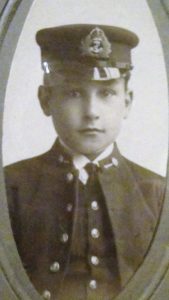
David had an eventful life. He served as an officer in the Royal Navy during World War One. In 1916 it was reported that he had been killed at the Battle of Jutland, but in fact he was a Prisoner of War. He later returned to duty and in 1919 was awarded the Albert Medal for gallantry in saving life at sea. On leaving the Royal Navy he joined the Palestine Police, where he married and had a son. Returning to England he took a job as a salesman, but then, in 1938, became an Observer in Czechoslovakia, in which role he was commended by Lord Halifax.
In March 1939 he was to meet a sudden and tragic end. Returning to England, in the Naval Reserve and with global conflict again on the horizon, he went on a refresher course at Portland, Dorset, walked out of his hotel, and later his body was found in the sea off Chesil Beach. For further information on David Wainwright see here.
Come back soon for some more Minor Pieces featuring chess players from Twickenham, Richmond and who knows where else.
Sources:
ancestry.co.uk
findmypast.co.uk
chessgames.com
BritBase
MegaBase 2022
EdoChess
British Chess Magazine 1933
Various other websites linked above.

